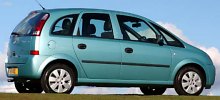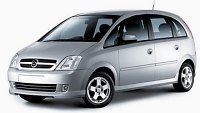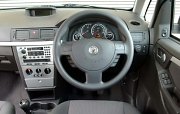|
Japanese
car makers has been producing small MPVs for many years, for example,
Mitsubishi
Toppo, Toyota Yaris Verso, Mazda Demio and many K-cars. In Europe, the
development was relatively slow. Since Renault Scenic brought the trend
of MPV into C-segment (Golf class) in 1996, European car makers have
not
yet tried to expand the MPV fever to smaller segments. Surprisingly,
the
first European car maker exploring this new segment is not the French,
but the traditionally conservative Opel. Under the leadership of CEO
Carl
Peter Forster, Opel is reinventing itself as an innovative car maker.
Not
believe? look at the Zafira, Meriva and Signum, these kind of
unconventional
cars will account for 40% of the company’s sales. Niche coupes and
roadsters
will account for another 20%, leaving conventional cars like Corsa,
Astra
and Vectra only 40%. With such a brave new strategy, no wonder Opel can
be the first one to launch a Corsa-sized MPV - the Meriva.
  
Meriva
is derived from the Corsa platform using the same essential
mechanicals.
That means it has significant advantage over its Scenic-class rivals in
terms of production cost. You might expect it to be much smaller than
Scenic,
but in fact Opel has done a great job by enlarging it significantly -
it
is 23cm longer than the Corsa, 5cm wider and 18cm taller. That’s just
marginally
shorter than the Scenic but the Meriva is taller and have a longer
wheelbase.
As a result, the 5-seat cabin is spacious, offering more legroom than
Astra
and vast of headroom.
The
highlight of Meriva is a flexible seating system called FlexiSpace. The
rear bench is normally a 3-seater. For a car this small, inevitably
shoulder
room will be tight for 3 passengers at the back. However, if there are
only 2 passengers there, the FlexiSpace rear bench can be converted
into
a 2-seater - the center part of the seat folds and drops down, then the
outer seats can be slid closer towards each other and release more
shoulder
room for both passengers. Now the outer seats are no longer blocked by
the rear wheelarches thus can slide back to release 200mm extra
legroom,
bravo! the backrests can also recline for better comfort.
In
case you want more luggage space, the rear seats can fold down
completely
onto the floor to form a flat loading platform for 2005 litres of
luggage,
mountain bikes, ski boards, whatever. Other useful utilities include
fold
tables behind the front seat backs, a tray under luggage floor and a
lot
of storage cubbies throughout the cabin. Meriva has the most brilliant
cabin ever seen for a 5-seat MPV.
In
mechanical aspect, the Meriva is just average. The target was to make
it
easy to drive and comfortable to travel in, even in the expense of some
body control and steering feel. All controls are lightweight to please
female buyers. That’s understandable, but its drivetrain does not live
up to expectation. The 100hp 1.6-litre 16V used to be sweet revving,
but
in this heavier car it needs to work harder and generates more noise
than
desired yet performance is just so-so. Another engine is a 123hp 1.8,
which
is also noisy at high rev, although power is not lack of. Gearshift of
the 5-speed gearbox is unpleasantly notchy.
Anyway,
with the clever packaging and the right price, Opel is confident to
sell
200,000 units of Meriva every year. It will also be sold in Brazil in
the
badge of Chevrolet Meriva. |